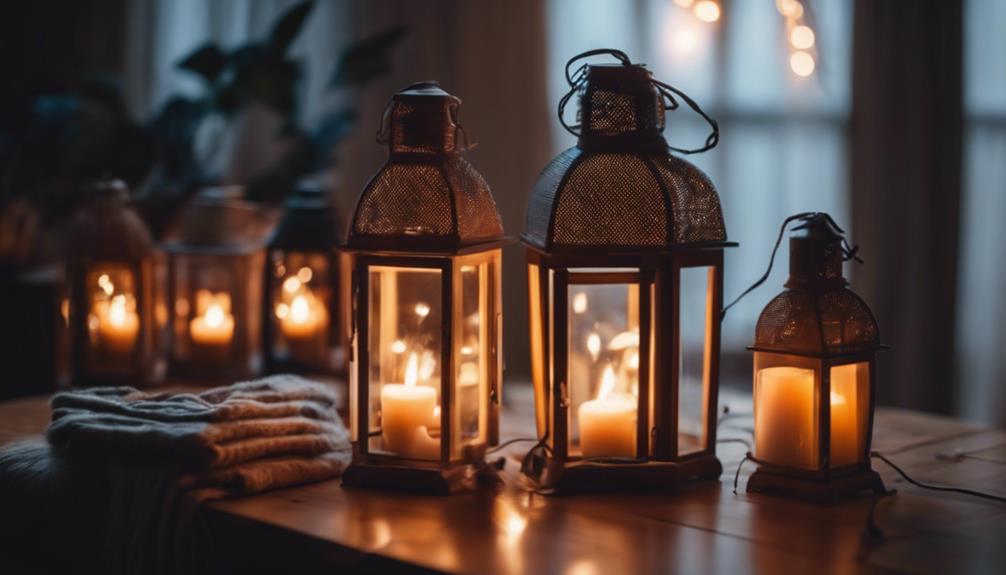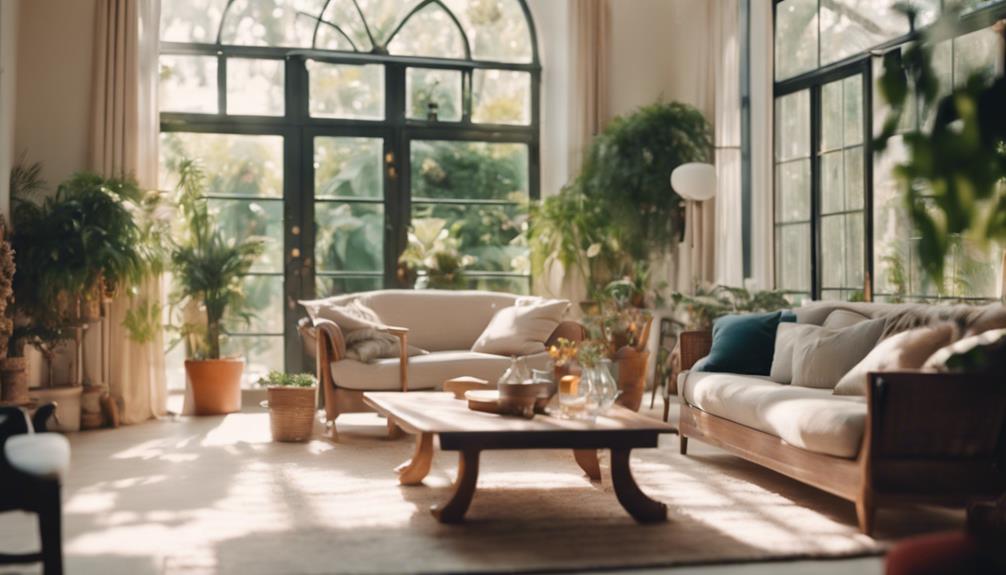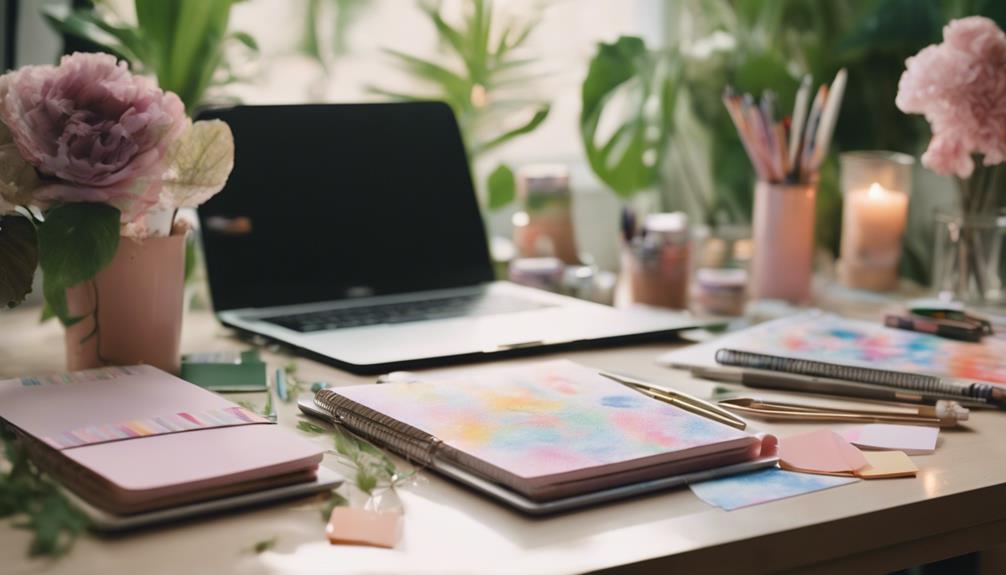You can set the perfect mood in any room with a few simple lighting techniques. Start by layering ambient, task, and accent lighting to create depth and visual interest. Use warmer tones to invite warmth, or cooler tones for a fresh, energizing vibe. Don't forget to incorporate dimmable options for those calming nights in or romantic dinners. Adding smart lighting technology lets you customize brightness and color to suit your needs seamlessly. Enhance your space further by introducing plants and natural materials. There's so much more to explore about lighting that can truly transform your atmosphere!
Key Takeaways
- Utilize a combination of ambient, task, and accent lighting to create a layered and dynamic atmosphere in any room.
- Adjust brightness and color temperature with smart lighting to tailor the mood for various occasions and activities.
- Incorporate dimmable options to enhance relaxation and create a calming environment, especially in spaces like bedrooms and living rooms.
- Highlight personal items and artwork with accent lighting to add emotional resonance and visual interest to your decor.
The Power of Lighting

Lighting shapes how you experience a space, affecting everything from color perception to your overall mood. When you adjust your lighting, you're not just illuminating the room; you're crafting an atmosphere.
The color temperature of your lights can dramatically change how you perceive the hues of your walls and furniture. For instance, warmer tones can make colors feel richer and more inviting, while cooler tones might create a more modern and energetic vibe.
To create a balanced atmosphere, consider using multiple light sources. Layering different types of lighting—ambient, task, and accent—can evoke various feelings. Soft, dimmed lights can foster relaxation, making them perfect for winding down after a long day, while brighter lights can energize and motivate you during work or activities.
Smart lighting technology is a game-changer, allowing you to customize brightness and color temperature based on your needs. This flexibility means you can easily shift from a cozy dinner ambiance to a vibrant gathering space.
Creating Emotional Spaces

Creating emotional spaces involves thoughtfully curating elements that resonate with your personal experiences and foster a sense of well-being. Your room should reflect who you are, using interior design to evoke feelings of happiness and relaxation.
Start by decluttering and simplifying decor; this creates a peaceful environment that reduces anxiety and promotes serenity.
Incorporate personal items, like books or mementos, to enhance the emotional resonance of the space. These elements add character and a connection to your memories.
Consider bringing in outdoor elements, like plants, to create a seamless indoor-outdoor feel, which can further uplift your mood.
Lighting plays an essential role in setting the emotional tone. Utilize multiple light sources, such as floor lamps and wall sconces, to create varied moods throughout your room. Choose warm light bulbs for a cozy atmosphere or brighter bulbs for a more energetic vibe.
By adjusting your lighting, you can balance calmness with personal passion, making your space a true reflection of yourself.
With these tips, you'll transform any room into an emotionally rich sanctuary that nurtures your well-being.
Techniques for a Calming Atmosphere

To create a calming atmosphere, you can start by dimming your lights to foster relaxation and peace within your space.
Incorporating outdoor elements like plants or allowing natural light to flow in can also enhance this serene vibe.
These simple adjustments can transform any room into a tranquil retreat.
Dimming Lights Effectively
Dimming lights effectively transforms any room into a soothing retreat, promoting relaxation and comfort. By adjusting brightness levels, you create an ambiance that invites calmness, allowing you to unwind from a busy day. Gradual shifts in lighting prevent abrupt changes that can disrupt your peace, making your environment more tranquil.
To enhance your lighting experience, consider the following techniques for effective dimming:
| Technique | Description | Benefits |
|---|---|---|
| Smart Technology | Schedule gradual dimming throughout the day | Adjusts mood with daily activities |
| Dimmable LED Bulbs | Customize brightness to suit your needs | Tailors lighting for occasions |
| Layered Lighting | Combine different light sources | Adds depth and dimension |
Incorporating dimmable lighting options not only improves functionality but also enhances the overall living experience. With these techniques, you can easily customize your space, creating the perfect atmosphere for relaxation. Whether you're enjoying a quiet evening or hosting friends, effective dimming lights will elevate your environment and mood.
Incorporating Outdoor Elements
Incorporating outdoor elements like plants and natural light can instantly transform your space into a calming oasis.
Start by adding greenery to your dining room; it's been proven that the presence of plants reduces stress and enhances your mood. Choose low-maintenance options like succulents or ferns that thrive indoors, bringing a touch of nature right into your home.
Maximize natural light by using large windows or skylights, allowing sunlight to flood your dining room. This not only brightens the space but also creates a serene atmosphere, making meals more enjoyable. If privacy is a concern, consider sheer curtains that let light in while still offering some coverage.
To further enhance the calming vibe, incorporate natural materials in your decor. Wood or stone elements add warmth and grounding, aligning perfectly with biophilic design principles. Choose soft textures and earthy colors to evoke a sense of tranquility, making your dining room feel like an extension of the outdoors.
Balancing Light and Decor

Balancing light and decor transforms a space, making it not only functional but also visually appealing. Imagine your room without proper lighting; it would look flat and uninviting. To achieve that perfect balance, layer different types of lighting: ambient, accent, and task. This layering creates a dynamic atmosphere and enhances the overall aesthetic.
Thoughtfully placing multiple light sources—like floor lamps, table lamps, and wall sconces—adds visual interest and allows for varied moods every day. For instance, using dimmable lights helps maintain a soothing environment, letting both your eyes and mind adapt smoothly to changes in light.
Incorporating personal items, such as books and artwork, with strategic lighting adds character and emotional resonance. Highlighting these pieces with the right light makes your space feel inviting and uniquely yours.
Don't forget about smart lighting systems; they allow you to customize brightness and color temperature, harmonizing your lighting with different decor styles and activities. By balancing light and decor, you can create a beautiful, functional space that enhances your daily living experience.
Insights From Design Experts

When it comes to lighting, creating an emotional connection is key.
You'll want to balance function and aesthetics to enhance both comfort and style in your space.
Design experts suggest that thoughtful lighting choices can transform a room, making it feel more inviting and personalized.
Emotional Connection Through Lighting
Effective lighting shapes emotional connections in your space, influencing how you perceive colors and the overall atmosphere. Designers emphasize that lighting is essential in creating a mood that resonates with your feelings. For instance, soft, flattering light can boost your self-confidence and promote relaxation during personal interactions.
Consider these tips to enhance your emotional connection through lighting:
- Use warm tones: They can create an inviting and intimate environment.
- Incorporate candles: Their flickering light evokes romance and enhances emotional resonance.
- Utilize smart technology: Customizable settings allow you to adjust the light to match your mood, whether you want to energize or calm down.
- Highlight personal items: Thoughtful lighting around your cherished books or photos tells your story and makes the space uniquely yours.
Balancing Function and Aesthetics
Striking the right balance between functionality and aesthetics in lighting design is essential for creating spaces that are both practical and visually appealing. To achieve this, consider layering different types of lighting: ambient, accent, and task. This combination not only meets your functional needs but also enhances the overall ambiance of your room.
Utilizing smart lighting technology can further elevate your space. With customizable brightness and color settings, you can easily adjust your lighting for specific tasks while setting the mood for relaxation or entertainment.
Incorporating personal elements, like books and decorative items, alongside thoughtful lighting choices adds character and emotional resonance, making your space truly yours.
Don't underestimate the power of dimming lights and using multiple light sources. These techniques can transform the atmosphere, helping you create a soothing environment that reflects your individual style.
Smart Lighting Solutions

Smart lighting solutions transform your spaces by allowing you to easily customize brightness and color temperature to suit any mood or occasion. With just a tap on your smartphone or tablet, you can create the perfect ambiance for entertaining guests or winding down after a long day.
Here are some features you'll love about smart lighting:
- Customizable Scenes: Set specific lighting scenarios for romantic dinners, movie nights, or vibrant gatherings.
- Gradual Changes: Enjoy smooth light alterations that prevent jarring shifts, letting your eyes and mind adjust comfortably.
- Multi-Layered Options: Use smart bulbs for ambient, accent, and task lighting, enhancing both function and aesthetics.
- Scheduling Capabilities: Program your lights to turn on or off at certain times, making routines effortless.
Embrace the ease and versatility of smart lighting to elevate your home's atmosphere. Whether you want a cozy retreat or a lively party vibe, the right lighting can make all the difference!
Layering Your Lighting

Layering your lighting combines ambient, accent, and task lighting to create a versatile and inviting atmosphere in any room.
Ambient lighting serves as the foundation, providing general illumination. To enhance the space, add accent lighting that highlights artwork or architectural features, drawing attention and adding depth. Task lighting is essential for specific activities like reading or cooking, ensuring you have adequate light where you need it most.
Consider using customizable LED bulbs, which allow you to adjust brightness and color based on your needs. This flexibility lets you easily set the perfect mood for various occasions, from a cozy night in to an energetic gathering with friends. By programming specific scenes, you can alter the atmosphere effortlessly.
Incorporating multiple light sources at different heights and angles not only enhances visual interest but also adds dimension to your space. This approach reduces reliance on single-source fixtures, giving you more control over your environment's ambiance.
With layered lighting, you'll create a dynamic and inviting atmosphere that meets both aesthetic and functional needs, making every room feel just right for any occasion.
Exploring Alternative Light Sources

In addition to traditional lighting options, exploring alternative light sources can greatly enhance the atmosphere and mood of your space. By incorporating unique lighting elements, you can create a more inviting and personalized environment. Here are some options to contemplate:
- Himalayan salt lamps: These emit a warm, inviting glow that promotes relaxation and soothes the atmosphere in any room.
- Colored light bulbs: Adjust hues to fit various settings, like soft pink for romance or calming blue for relaxation.
- Philips Hue lights: With customizable color settings, you can easily tap on your smartphone to create specific ambiances tailored to your mood.
- Orange light: This color is linked to increased sex drive and playfulness, making it a fantastic choice for intimate spaces.
Frequently Asked Questions
How to Set the Mood With Lighting?
To set the mood with lighting, you can adjust brightness and color temperature using smart technology. Layer your lights, experiment with dimming, and choose warm or cool tones to create the perfect atmosphere for any occasion.
What LED Light Puts You in a Good Mood?
To boost your mood, try warm LED lights around 2700K to 3000K. Incorporate colored bulbs like orange or purple for playfulness, and use dimmable options to adjust brightness for a calming, inviting atmosphere.
How Does Room Lighting Affect Mood?
When it comes to lighting, you can't judge a book by its cover. The right lighting transforms your mood, creating warmth and comfort or energizing a space, directly influencing how you feel and interact.
What Is the Best Lighting for Love Making?
For making love, soft, warm lighting works best. Use dimmed lights or candles to create intimacy. Consider colored bulbs for added playfulness or romance, ensuring the atmosphere feels inviting and relaxing for both of you.
What Are Some Tips for Setting the Perfect Mood with Lighting in Any Room?
Creating the perfect ambiance in any room can be achieved with the right lighting. Utilize soft, warm tones for a cozy feel, and bright, cool tones for an energizing effect. Layering different light sources, like overhead, task, and accent lighting, can enhance the overall atmosphere. These perfect lighting tips for home can help transform any space.
Conclusion
You've learned that lighting isn't just about brightness—it's about mood, too. By layering your lights and exploring smart solutions, you can create spaces that feel just right.
Remember, a calming atmosphere can emerge from the flick of a switch, while decor can shine brighter with the perfect glow. Coincidentally, as you transform your rooms, you'll discover the magic of light in every corner.
So go ahead, let your creativity flow and watch your spaces come alive!









